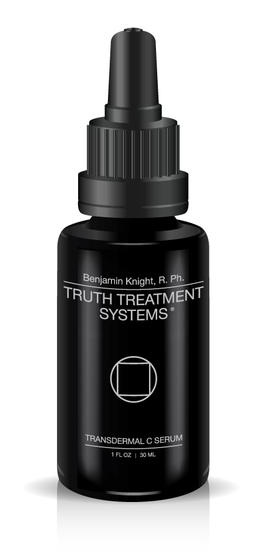
Transdermal C Serum
Highlights
Key Ingredients
Skim through
| Ingredient name | what-it-does | irr., com. | ID-Rating |
|---|---|---|---|
| Tetrahexyldecyl Ascorbate (Vitamin C) | antioxidant, skin brightening | goodie | |
| C12-14 Alkyl Benzoate | |||
| C10-30 Cholesterol/Lanosterol Esters | emollient, emulsifying, viscosity controlling | goodie | |
| (-)-Alpha-Bisabolol | soothing | goodie | |
| Stearyl Glycyrrhetinate (From Licorice Root) | soothing |
Truth treatments Transdermal C SerumIngredients explained
Tetrahexyldecyl Ascorbate is a stable, oil-soluble form of skincare big shot Vitamin C. If you do not know, why Vitamin C is such a big deal in skincare, click here and read all about it. We are massive vitamin C fans and have written about it in excruciating detail.
So now, you know that Vitamin C is great and all, but it's really unstable and gives cosmetics companies many headaches. To solve this problem they came up with vitamin C derivatives, and one of them is Tetrahexyldecyl Ascorbate (let's call it THDA in short).
It's a really promising candidate (see below), but while reading all the goodness about it in a minute, do not forget that derivatives not only have to be absorbed into the skin but also have to be converted to pure vitamin C (ascorbic acid or AA) and the efficacy of the conversion is often unknown. In addition, vitamin C's three magic properties (antioxidant, collagen booster, skin brightener) are all properly proven in-vivo (on real people), but for the derivatives, it's mostly in-vitro studies or in the case of THDA, it's in-vitro and done by an ingredient supplier.
With this context in mind let's see what THDA might be able to do. First, it is stable (if pH < 5), easy to formulate, and a joy to work with for a cosmetic chemist.
Second, because it's oil-soluble, its skin penetration abilities seem to be great. So great in fact, that it surpasses the penetration of pure vitamin C threefold at the same concentration and it penetrates successfully into the deeper layers of the skin (that is usually important to do some anti-aging work). There is also in-vitro data showing that it converts to AA in the skin.
Third, THDA seems to have all three magic abilities of pure vitamin C: it gives antioxidant protection from both UVB and UVA rays, it increases collagen synthesis (even more than AA) and it has a skin brightening effect by reducing melanogenesis by more than 80% in human melanoma cell cultures.
So this all sounds really great, but these are only in-vitro results at this point. We could find Tetrahexyldecyl Ascorbate mentioned only in one published in-vivo study that examined the anti-aging properties of a silicone formula containing 10% AA and 7% THDA. The authors theorized that the 10% AA is released slowly from the silicon delivery system and probably stays in the upper layer of the skin to give antioxidant benefits, while THDA penetrates more rapidly and deeply and gives some wrinkle-reducing benefits. The study was a small (10 patients), double-blind experiment, and the formula did show some measurable anti-aging results. However, it is hard to know how much pure vitamin C or THDA can be thanked.
Bottom line: a really promising, but not well-proven vitamin C derivative that can be worth a try especially if you like experimenting (but if you like the tried and true, pure vitamin C will be your best bet).

A clear, pale yellow oil-like liquid that's claimed to be similar to the lipids that are naturally in the outermost layer of the skin. It's not only similar to them but it is also biomimetic, meaning that it can mimic the functionality of our skin lipids.
The skin lipids play a super important role in maintaining a healthy skin barrier and keeping the skin nice and moisturized and not dry or cracked. So C10-30 Cholesterol/Lanosterol Esters, aka Super Sterol Liquid can do something similar: it is an extremely efficient emollient that can repair even dry hands or cracked lips and it is great at maintaining a healthy skin barrier.
A goodie for super dry skin.
It's one of the active parts of Chamomile that contains about 30% of bisabolol. It's a clear oily fluid that is used in skincare as a nice anti-inflammatory and soothing ingredient.

You may also want to take a look at...
| what‑it‑does | antioxidant | skin brightening |
| what‑it‑does | emollient | emulsifying | viscosity controlling |
| what‑it‑does | soothing |
| what‑it‑does | soothing |





